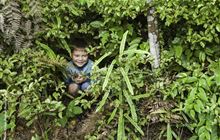Podocarp-hardwood forests
Introduction
Podocarp trees include rimu, kahikatea, miro, mataī and tōtara.Podocarp trees boast a lineage that stretches back to the time when New Zealand was part of the super continent of Gondwana.
New Zealand has 15 podocarp tree species belonging to the coniferous families Podocarpaceae (13 species), Phyllocladaceae (3 species). The best known are rimu, kahikatea, miro, mataī and tōtara.
In its natural state, a podocarp forest can be lush with a dense undergrowth of shrubs, ferns and tree-ferns. The few precious remnants of forest which survive often contain the highest diversity of plants and animals in the region. They are a left-over from an ancient forested time.
Where are they?
Much of New Zealand looks like a large patchwork quilt of rural farmland. Occasionally dotted throughout the low-land agricultural landscape are areas of native podocarp-hardwood forest. These show us what much of the region would have once looked like.
Unfortunately, their rich soils have largely led to the demise of these forests when the land is used for farming.
Podocarp forests can still be found in some parts of the central North Island, Taranaki,Coromandel, Northland and in Southland. The largest podocarp forests are on the west coast of the South Island.
Podocarp facts
Podocarp forests are a mixture of tall podocarps and smaller trees (hardwoods) with an understorey of shrubs, plants and ferns. Light-loving podocarps reach for the forest canopy, while shade tolerant species thrive in the darker lower levels.
Soil and climate conditions play a major role in determining which species will be the most dominant in a forest. In Southland, tōtara grows closest to the coast, on almost pure sand. As the soil nutrient levels increase, mataī will grow. With more nutrients rimu and miro will come into the forest. On the wetter sites kahikatea grows best.
Podocarps like all plants in the conifer family reproduce using cones, but podocarp cones are extremely modified and look more like berries. These are attractive to birds which help to spread the seeds.
Because of the abundant range of fruits, podocarp forests also support larger communities of insects and birds such as bellbird, tūī, kākā and kea.
The giants
Rimu (Dacrydium cupressinum)
Able to reach up to 50 metres in height, the rimu is well known for its strong, durable timber often used in furniture, although very little is milled these days.
Kahikatea (Dacrycarpus dacrydioides)
The kahikatea or white pine is New Zealand’s tallest native tree reaching up to 60 metres high. Black seeds, produced in autumn at the end of a succulent red stem, are popular with wood pigeon (kūkupa or kererū), kākā and tūī. Kahikatea is one of the most reduced forest types in New Zealand, once dominating in lowland swamp areas.
Miro (Prumnopitys ferrugineus)
Growing up to 25 metres high, the miro bears pinkishpurple fruit especially in autumn to early winter, which is a favourite food of kākā and wood pigeons.
Mataī (Prumnopitys taxifolia)
Bees collect pollen from the small yellow catkins in October and November while the round blue-black fruit is enjoyed by kākā and wood pigeons. Although quite slimy the fruit are sweet and were eaten by early Māori. When mataï was being felled for timber, bushmen drilled the base of standing trees to collect a sap known as mataī beer.
Tōtara (Podocarpus totara)
Tōtara grow up to 30 metres tall, with massive trunks. They were used by the Māori for canoes and carving. It dominates on some sandy coastal areas such as Otatara.
Threats
- Land clearance and timber harvesting has reduced the size of our podocarp forests.
- Possums do enormous damage to native New Zealand forests. They also compete with native animals for food, and prey upon birds, their eggs and nestlings.
- Weeds, often garden escapees, have invaded our forests and in many cases out-compete native plants.
- Browsing by introduced mammals such as deer and sheep seriously limit the ability of a forest to regenerate.
- Fire is an obvious threat to forest, and fire restrictions apply all year round to many areas of land managed by DOC.
You can help
- Take note of any signs warning of poison and other DOC signs.
- Do not interfere with native birds or the traps and bait stations that are there to protect them.
- Do not take your dogs into national parks. Restrictions may apply elsewhere.
- Keep your dog under control in places where they are allowed.
- Pay attention to fire warnings and local weather conditions
- Always remember to take rubbish with you.

